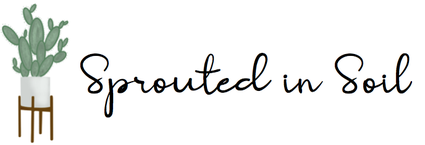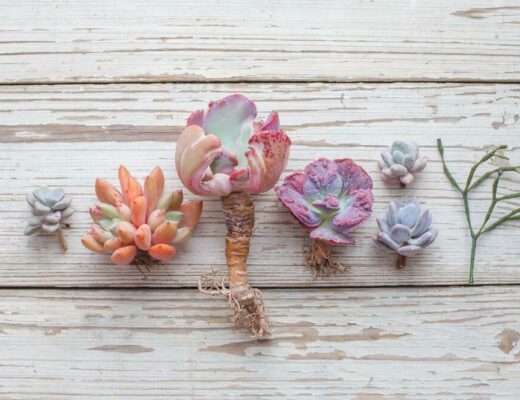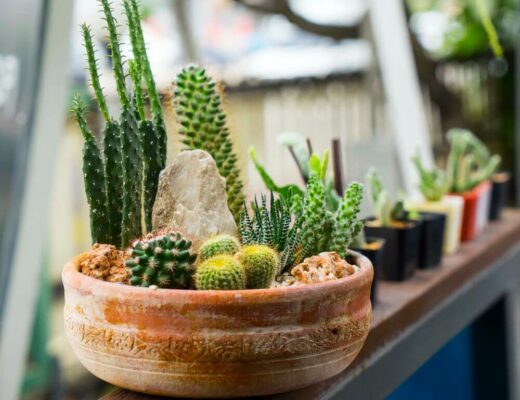Many types of jade plants are well known throughout the succulent world and beyond. Despite this, most people don’t realize that these are actually different species within the genus Crassula!
The popular ‘Jade Plant’, or Crassula ovata is just one species of about 200 that make up the Crassula genus. This genus encompasses succulents of different shapes, colors, growth habits, textures and sizes, making it incredibly diverse.
In addition to the numerous jade plant varieties, the Crassula genus has a whole host of other beautiful species that have similar care needs to that of the ‘Jade Plant’. This list will give you a grand introduction into the countless number of plants within the Crassula genus.
Table of contents
1.Crassula ovata ‘Jade Plant’
Let’s start with the most well known Crassula. You may have heard of it being called a ‘Jade Plant’, ‘Lucky Plant’ or ‘Money Tree’. According to the Chinese practice of Feng Shui, Crassula ovata is said to represent luck, prosperity and money. I cannot promise these good fortunes, however I can guarantee that the ‘Jade Plant’ is a forgiving, easy-to-grow succulent.

The ‘Jade Plant’ has thick, waxy oval leaves that line brown wooden stems. As it matures the main stem and branches will become thicker, reminiscent of a tree trunk.
Depending on where and in what a ‘Jade Plant’ is grown, a mature plant can vary greatly in size. If kept in a small to medium sized pot, a Crassula ovata will stay on the smaller size and can be pruned into a bonsai. If grown outdoors, this succulent can grow into a large bush of three or more feet.
‘Jade Plants’ unfortunately don’t usually flower when kept indoors. If you are lucky enough to see its blooms, you will catch sight of the delicate white star-shaped flowers. If grown outside in conditions similar to its native origin of South Africa, you will have a much higher chance of seeing these snowy flowers.
‘Jade Plants’ grow best in a window that receives a handful of hours of morning light and bright indirect light in the afternoon. Water only when the soil is completely dry and you will have a happy plant on your hands.
- Mature Size: 3-6’ tall, 2-3’ wide
- Hardiness: Zones 10-11
2. Crassula ovata ‘Botany Bay’
The ‘Botany Bay’ is another type of jade plant that was first created in 2011. When provided with dry conditions and consistently bright direct sunlight, the leaves of ‘Botany Bay’ blush with a red hue along the edges.

The leaves are very similar to that of a Crassula ovata but you will notice that ‘Botany Bay’ grows in a more compact manner with leaves stacked closer together on stems.
- Mature Size: 3’ tall
- Hardiness: Zones 10-11
3. Crassula ovata ‘Minima’
As it’s name would imply Crassula ovata ‘Minima’ is a miniature version of the ‘Jade Plant’. ‘Minima’ will have smaller leaves and only tend to reach a mature size of less than two feet.

Crassula ovata ‘Minima’ has leaves that are more tightly packed on the stems than most other jade plants. This feature gives ‘Minima’ a more tree-like appearance, which is perfect if you want to create a garden of bonsai trees.
Just like its bigger counterpart, ‘Minima’ should be placed in a window that receives direct morning light. Direct afternoon light can be too strong and cause its leaves to burn.
- Mature Size: 2’ tall, 1.5’ wide
- Hardiness: Zones 10-11
4. Crassula ovata ‘Tricolor Jade’
A stunning variety of jade plant, this succulent has variegated white leaves, striped with lime green accents. When under stressful conditions, you can expect the edges of the leaves to turn a vibrant deep pink/purple. A perfect stressful environment to elicit this change includes bright light and drought-like conditions.

Like other jade, the size of a mature plant can vary based on where it is planted. If planted in a pot indoors, you will have a medium sized plant. If grown outdoors, this vertical grower has been known to reach up to eight feet in South Africa.
- Mature Size: 1’ tall
- Hardiness: Zones 10-11
5. Crassula ovata ‘Gollum’
Here is where we begin to see how different each type of Jade can be. Commonly known as ‘Gollum Jade’ or ‘Finger Jade’, this jade variety has bright green, curled, tubular leaves that grow upwards, away from the stem. Like most other jade, Crassula ovata ‘Gollum’ will grow to have a long woody stem.
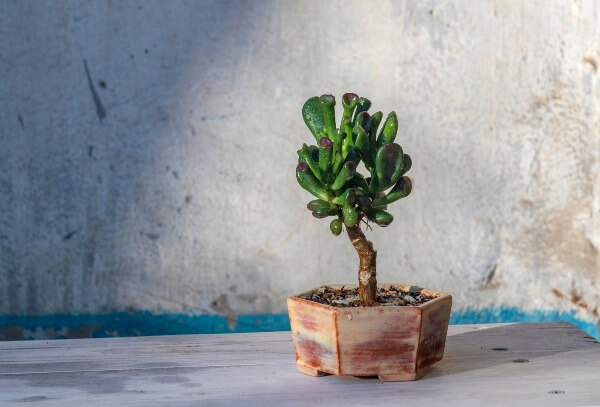
If kept in a bright window, the tips of these curled leaves will redden with increased sun exposure. Plant in gritty, well draining soil and water infrequently.
- Mature Size: 2’ tall, 1’ wide
- Hardiness: Zones 10-11
6. Crassula arborescens
Crassula arborescens’ gray/blue leaves are lined with a distinctive maroon color that makes this jade plant extra special. While this succulent looks fancy, it still has the same easy, hands-off style of care as the rest of the jade family.

- Mature Size: 4-5’’ tall
- Hardiness: Zones 10-11
7. Crassula ‘Moonglow’
‘Moonglow’ is one of my favorite trailing Crassula. While this succulent is slow growing, it will add a velvety texture to your jade collection.
The fleshy silvery green leaves grow tightly pancaked one on top of another. As leaves are added to the stem, it will slowly begin to topple over pots due to its heaviness. When you remove leaves, another stem will grow in its place, creating more offshoots.
Place in a pot with a drainage hole and well-draining soil because this Crassula is very sensitive to overwatering. Too much water can cause the plant to be susceptible to rust fungus. To avoid the risk of rust fungus, make sure ‘Moonglow’ is placed in bright sunlight and only water when the soil is completely dry.
- Mature Size: 12” tall, 6” wide
- Hardiness: Zones 10-11
8. Crassula arborescens undulatifolia
Also known as ‘Ripple Jade’, Crassula arborescens undulatifolia has wavy thin leaves with light gray/green coloring. You will also notice that unlike the shiny leaves of other jade’s, ‘Ripple Jade’ boasts a matte texture.

Another difference that you will notice is that ‘Ripple Jade’ will not develop woody stems. Instead their stems stay a tender green.
- Mature Size: 3-4’ tall
- Hardiness: Zones 10-11
9. Crassula marnieriana ‘Baby’s Necklace’
‘Baby Necklace’ is just one of the many names given to this species. You may also have heard of this plant referred to as ‘Worm Plant’ or ‘Jade Necklace Plant’. ‘Baby’s Necklace’ is a branching, trailing succulent made up of miniature light green chubby leaves that grow tight around the stem like buttons.

This plant is perfect as a filler in succulent arrangements or in a hanging basket because it cascades over the edges of pots creating delicate waterfalls of leaves.
- Mature Size: 12” long
- Hardiness: Zones 10-11
10. Crassula swaziensis ‘Money Maker’
This succulent’s leaves have a very similar appearance to the standard Crassula ovata and other jade plant varieties. It differs in its texture and growth pattern.
The lime green leaves are covered in miniature white hairs, giving it a velvety appearance. The leaves are thick and rimmed in red when exposed to enough sunlight. “Money Maker’ grows vertically like other jades but in a much bushier pattern.
‘Money Maker’ can be pruned as a bonsai. Use the cuttings obtained from pruning to create new plants via propagation.
- Mature Size: 8” tall,
- Hardiness: Zone 10
11. Crassula pellucida f. Variegata ‘Calico Kitten’
‘Calico Kitten’ is a blush pink succulent with stacked, heart-shaped leaves that grow on trailing stems. This succulent would be a perfect addition to a hanging basket to add a burst of color.
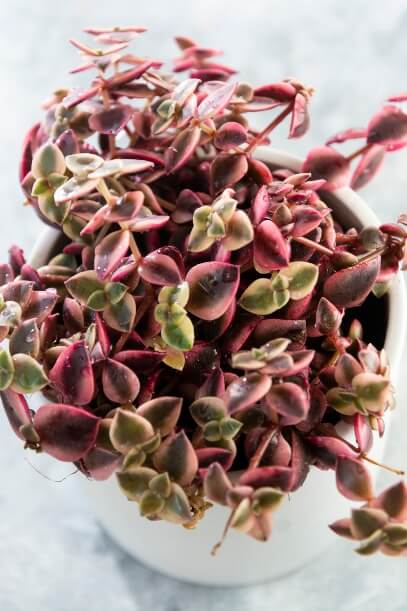
I ensure that my ‘Calico Kitten’ has bright morning sun exposure to maintain and deepen its pink hue. As with other Crassula, plant this in gritty well draining soil to avoid root rot.
- Mature Size: 9-12” tall
- Hardiness: Zone 10
12. Crassula multicava
‘Crassula multicava’ has tender, thin leaves that resemble spinach leaves. While the color is a lighter green than spinach, it has a very similar vein pattern.
The branches are sturdy so this plant will grow vertically and not bend with additional growth. Given it’s delicate leaves, Crassula multicava would be a great substitute for other greenery, such as eucalyptus, in bouquets.
- Mature Size: 9-12” tall
- Hardiness: Zone 10
13. Crassula rupestris
Growing in a very similar pattern to ‘Moonglow’ and ‘Baby’s Necklace’, Crassula rupestris has small triangular light mint leaves bordered in lime green. The leaves are matte, instead of shiny like many other jade varieties.

Crassula rupestris does best in bright indoor light or partial sun outdoors. Bright sunlight will bring out a rim of burgundy red along the edges. Flowers bloom in clusters in the spring and are a light pink.
- Mature Size: 12” long
- Hardiness: Zone 10
14. Crassula congesta ‘Green Beans’
Crassula congesta ‘Green beans’ is a type of jade plant that has long chubby leaves that are soft and green. The stems are thin but strong, so don’t usually bend until the plant has become mature.
Place this succulent in bright filtered light so the leaves don’t burn and turn brown. Water this plant like you would any other jade variety and let the soil dry out between waterings.
- Mature Size: 8” long
- Hardiness: Zone 10
16. Crassula pubescens
‘Crassula pubescens’ is another miniature type of jade plant. It has small silken leaves that are covered in white fuzzy hairs. The leaves are green when planted in lower light but turn a fiery beet red when in full sun.

If you live in a mild area that doesn’t frost, ‘Crassula pubescens’ is a great option for a sprawling dense ground cover. When this variety of jade flowers, long red stalks appear and are topped with white pearly blooms clustered together.
- Mature Size: 1’ tall, 1’ wide
- Hardiness: Zones 9-11
17. Crassula ovata ‘Hummel’s Sunset’
This Crassua is aptly named. It is also known as ‘Golden Jade’ because of its glowing greenish-yellow leaves that are rimmed in a fluorescent red.

‘Hummel’s Sunset’ has glossy oval leaves and strong woody stems and branches, just like the other varieties of jade. It can be kept inside and pruned as a bonsai or grown outside in the appropriate hardiness zone as a dense shrub.
This succulent is a slow grower and extremely hard to kill, like most other Crassula, so is the perfect gift for newbies to the succulent world.
- Mature Size: 3’ tall, 2’ wide
- Hardiness: Zones 9-11
15. Crassula cotyledonis
This type of jade grows low in dense mounds instead of branching like other varieties. The leaves are flat oval pancakes featuring a gray green hue. Like many other Crassula, this succulent has velvety leaves that makes the plant appear silver at different angles.
- Mature Size: 6” tall
- Hardiness: Zones 9-11
18. Crassula ‘Pagoda Village’
The leaves of this stacked succulent form tight rosettes to create chains of green, red and purple. To keep the leaves compact, place your potted ‘Pagoda Village’ in a window that receives bright light all day and direct morning sun.
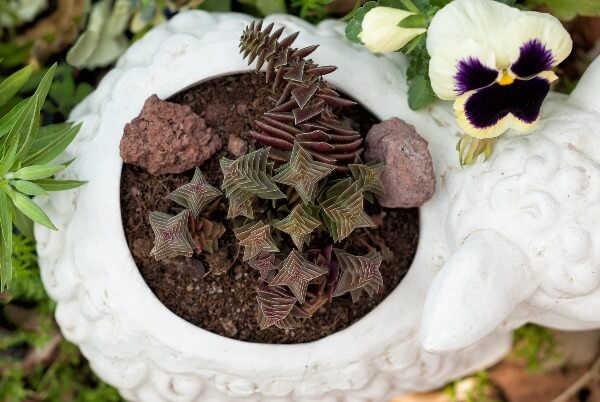
Because the stems begin to double over as it matures, ‘Pagoda Village’ is a great filler plant to add between other succulents in large pots.
- Mature Size: 10” long
- Hardiness: Zone 10
19. Crassula ‘Buddha’s Temple’
‘Buddha’s Temple’ is a cross between Crassula pyramidalis and Crassula perfoliata var. Minor. The combination of these two species make a fascinating stacked column of curved triangular leaves. This plant will bring a quirky geometric statement to your succulent collection.

Water infrequently to avoid root rot. Avoid getting water on the leaves. Because the heart shaped leaves grow so close together, water will not easily evaporate. This can lead to an increased chance of pests.
- Mature Size: 9-12” tall
- Hardiness: Zones 10+
Care Needs
The great thing about the genus Crassula and its numerous types of jade plants, is that it is very undemanding and forgiving succulents. Native to South Africa, Crassula do prefer dry conditions so only water when the soil is dry. However, there is no need to worry if you accidentally have a heavy hand once or twice while watering.
A drench-and-dry watering is best to keep you Jade plant at its happiest. Completely soak the soil with water and allow the excess water to drain out via a drainage hole at the bottom of the pot. Before watering again, ensure the soil is dry.
To check the moisture of the soil, stick a knife or chopstick in the pot. If it comes out clean, the soil is dry. If the utensil comes out with soil stuck to it, hold off watering for a couple more days.
Crassula love light and will perform best when given several hours of direct morning sunlight per day. This is not to say that they will do poorly in lower light conditions but you won’t see the show of color they put on when stressed by the sun. Avoid placing pots in hot, afternoon windows because jades are susceptible to burning.
It is best to plant Crassula in well draining, gritty soil. You can either buy prepackaged succulent and cactus soil or you can make your own.
I like to use the following mixture:
- 1 part organic material
- 1 part perlite or small pebbles
- 1 part coarse sand
It is important that the sand is coarse, not fine, so the mix doesn’t hold on to water.
Propagation
Another reason I love all types of Jade plants is that they are extremely easy to propagate. They grow roots slower than other succulents. In spite of this, I have the same amount of success propagating Crassula as I do other plants. Crassula can be propagated two different ways, leaf cuttings and stem cuttings.
Leaf Cuttings: Pick healthy, firm leaves and gently pluck from the branch or stem by slowly twisting back and forth. This method ensures you remove the entire leaf. Allow the end of the leaf to dry out, or callous over, for three to five days in a cool, dark area.
Once dry, place leaves on top of soil with the ends buried slightly underneath the soil. Mist daily to keep the soil moist. Continue to mist until you start to see new plants emerge, then back off and water only every two to three days.
Stem Cuttings: To propagate stem cuttings, take succulent pruning shears or a sharp sterile knife to cut a healthy stem at least four inches from the top.
Allow the end of the stem to callous over for three to five days.
Once dry, place the bottom 1 ½ + inches of the stem cutting into new soil. Cover the soil with a thin layer of fine pebbles. Place in a sunny window and do not water for the first week.
After this period begin watering generously, just as you would an adult plant. The pebbles help secure the new stem in the soil until roots are established.
Final Thoughts
The fact that most types of jade plants have minimal needs make this a great first plant for a budding enthusiast. As you expand your collection, you can continue to look into the Crassula genus to build a diverse family of plants because, as you have learned, there are so many different kinds of jade plants. With the various colors, textures and shapes, these succulents are sure to stand out.
